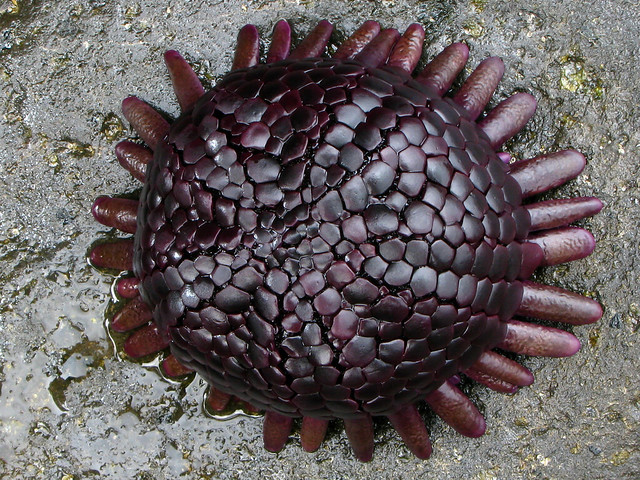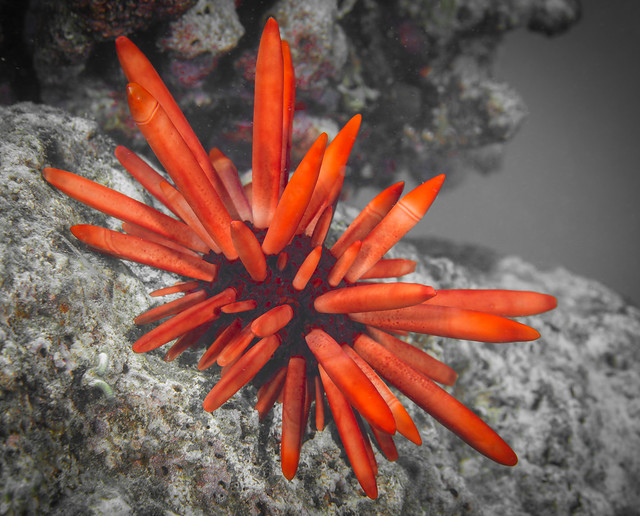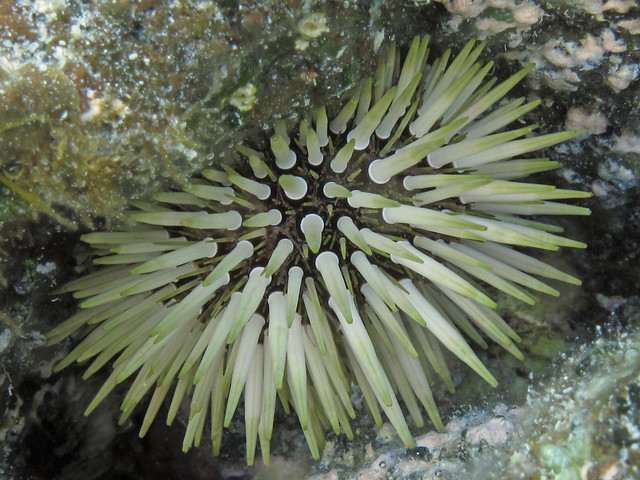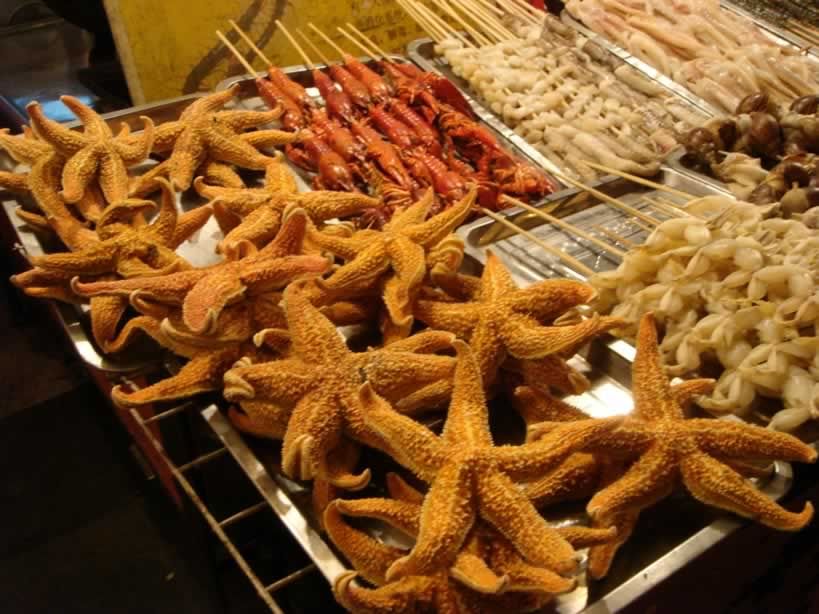My esteemed colleagues over at Deep-Sea News have declared this week (April 27-May 3) "Coral Week" and have gone into insane 100% coral-all-the-time mode.
So at Dr. McClain's delicate urging I thought I would present a little somethin' somethin' on the echinoderm-coral intersection.
One aspect I should mention of course, is that coral reefs-both deep and shallow provide habitats for echinoderms. Here...I look at more direct interactions..and interesting aspects of those relationships....
Sea Cucumbers (Class Holothuroidea) & Crinoids (Class Crinoidea): As far as I know, sea cucumbers and crinoids don't really interact directly with corals other than as substrate or when they form habitats (as in tropical shall0w-water or deep-sea coral reefs). And if you don't believe me about cukes not eating corals..ask Dr. Seville Kent from 1883 (note: this made Nature in the 19th Century!!). So, not much on those groups here.
Brittle Stars & Serpent Stars (Class Ophiuroidea): There are quite a few ophiuroids that live on various corals. My understanding is that relationships are generally commensal, with the ophiuroid living in or around the coral (and/or sometimes sponges). Both in tropical shallow-water and deep-sea habitats. Examples include:
* The six rayed Ophiothela danae from tropical shallow-water habitats
* Several deep-sea "serpent stars"(Phrynophiurida) i.e., those with big fleshy arms that split into massively branched arms such as this that often live on octocoral hosts.
*The Ophiacanthidae-a weird but diverse group of globally distributed spiny brittle stars). Shown here co-occurring with some deep-sea coral.
Ophiuroid-octocoral relationships are quite interesting. And various aspects of this research are being studied, including
systematic relationships
sublethal predation
and other aspects of feeding ecology and reproduction.
Perhaps though, one of the most significant relationship between echinoderms and corals is that several echinoderms EAT coral!!
Let's take a look at some prominent corallivorous echinoderms, shall we?
Diadema antillarum (class Echinoidea-sea urchins)
One of the few non-starfish echinoderms reported to feed on coral..Diadema is a member of the family Diadematidae, which are recognized by their long sharp, needle-like spines.
Diadematids are widespread throughout the tropical Atlantic and Indo-Pacific occuring primarily in shallow-water reef habitats with some deeper members.
Diadema is primarily an epifaunal algal grazer, leaving scar marks on substratum with relatively minimal corallivorous propensities.
What's curious is that much of the review literature (citations available upon request) attributes coral as a food source, when it may actually be that much of the perceived "feeding" is in fact, grazing.
Only one paper-Bak & Eys 1975 reported feeding in D. antillarum with gut content reports but reported "scars" from coral heads as well as various outlining various prey species but that doesn't really convince me that feeding on coral polyps was not merely incidental.
Bah. onward to some REAL corallivores....
Hippasteria spp. (Goniasteridae)
 Hippasteria (and the related genera Evopolosoma and Cryptopeltaster) are large, heavily calcified starfish with big thick spines that live primarily in cold-water areas, in other words the polar/sub-polar or deep-sea settings.
Hippasteria (and the related genera Evopolosoma and Cryptopeltaster) are large, heavily calcified starfish with big thick spines that live primarily in cold-water areas, in other words the polar/sub-polar or deep-sea settings.There are about 25-30 species with members occuring in the Arctic, New Zealand, Hawaii & Japan (deep-sea), the North Atlantic, the tropical West & South Atlantic (deep-sea) and throughout the North Pacific.
Krieger & Wing 2004 reported from their Alaskan/North Pacific study areas that in some of their study areas, Hippasteria spp. accounted for up to 45% of polyp predation on the soft-coral Primnoa. The North Pacific Hippasteria spinosa was reported by Birkeland 1974 to feed primarily on sea pens.
and without getting into too much detail, I've seen these feeding on deep-sea corals suggesting that when present, they are probably important members of deep-sea coral systems. What role and how important they are to those systems remains an open question....
Culcita novaeguineae (Oreasteridae)
A widespread genus with three species occuring throughout the tropical Indo-Pacific region. From Hawaii to India and the east coast of Africa. Varies widely in color and morphology but maintains its distintinctive swollen appearance. The name, Culcita, is latin for "cushion".
Various factoids taken from Glynn & Krupp 1982:
- Culcita prefers feeding on Pocillopora over Porites, Montipora, and Fungia
- Based on lab feeding results, Culcita can eat 1.0 square meter per year of Pocillopora or 0.9 square meters of mixed coral prey. This represents ONE FIFTH of the feeding rate of Acanthaster planci (see below) which is about 6 square meters a year.
- Abundance of Culcita is also FAR below what Acanthaster reaches.. Culcita was reported in one instance approaching 25 individuals per hectare vs. 65 individuals per hectre for Acanthaster. Based on this, it seems doubtful that Culctia could have a deleterious effect on reef growth.
- HOWEVER, Culcita seems to feed primarily on younger colonies and thus, could have an effect on coral community structure by limiting abundance of one species over another in different areas and in conjunction with Acanthaster could affect coral population structure.
Acanthaster planci (Acanthasteridae)
aka the Crown of Thorns Starfish or...COTS by some. The BIG one. A caveat here..this is a SHORT summary. Based on the amount of literature available on this animal, I could literally spend a whole frackin' WEEK just on the COTS.
Pursued, studied, and in many cases destroyed due to their perceived threat to shallow-water tropical reefs. Probably one of the most notorious, and as a consequence one of the best-studied, starfish in the world.
The COTS is widespread, occuring from Hawaii and southern Japan to the Pacific coast of Panama to the Indian Ocean on the east coast of Africa and as far south as the subtropical Kermadec Islands. Acanthaster varies widely over this range in color and morphology.
A whole book is devoted to the biology and ecology of Acanthaster planci. Much of my info here hails from this useful volume.
Two important aspects of COTS biology contribute to human concerns:
Acanthaster is a voracious predator of corals
Individual animals can ingest up to 6 square meters of living reef a year.
 Acanthaster has undergone huge bursts in population (known as "outbreaks")
Acanthaster has undergone huge bursts in population (known as "outbreaks")Accounts of these outbreaks have been estimated based on relative size based on catch records.
One study collected 8,083 individuals from American Samoa but surveys estimated that the total population to be 212,000 individuals!! (that's 26.5X as large!!)
Another study from American Samoa collected 486,933 but "so many thousand remained that no estimate was made of the proportions killed"
Interestingly, abundance can fluctuate by as many as six orders of magnitude within a year or two.
For example: Prior to late 1977, numbers of A. planci in American Samoa were of the order of less than 2 per year, as observed by "knowledgeable persons". By late 1977, HUNDREDS of THOUSANDS of starfish appeared on both sides of the main island!!!
These two issues combined have resulted in a LOT of COTS devouring coral and leaving dead white rubble in their wake...
So why the outbreaks? Different hypotheses have been advanced (I will caveat that there are probably others but these seem to be some of the two most prominent):
- The outbreaks are natural. Analysis of Acanthaster ossicles (i.e., fossil remains) were analysed and showed regular fluctuations.
- Outbreaks are caused or directed by anthropogenic (i.e., man-made) forces. For example, increased nutrient run-off from land resulting in higher juvenile survivorship and thus greater adults. An older idea, that overfishing of giant "trumpet shell" snails (Charonia) resulting in loss of natural predators has essentially been discounted as the sole cause.
Long Term outbreak monitoring on the Great Barrier Reef can be read-about here
Controlling Crown of Thorns Starfish





































